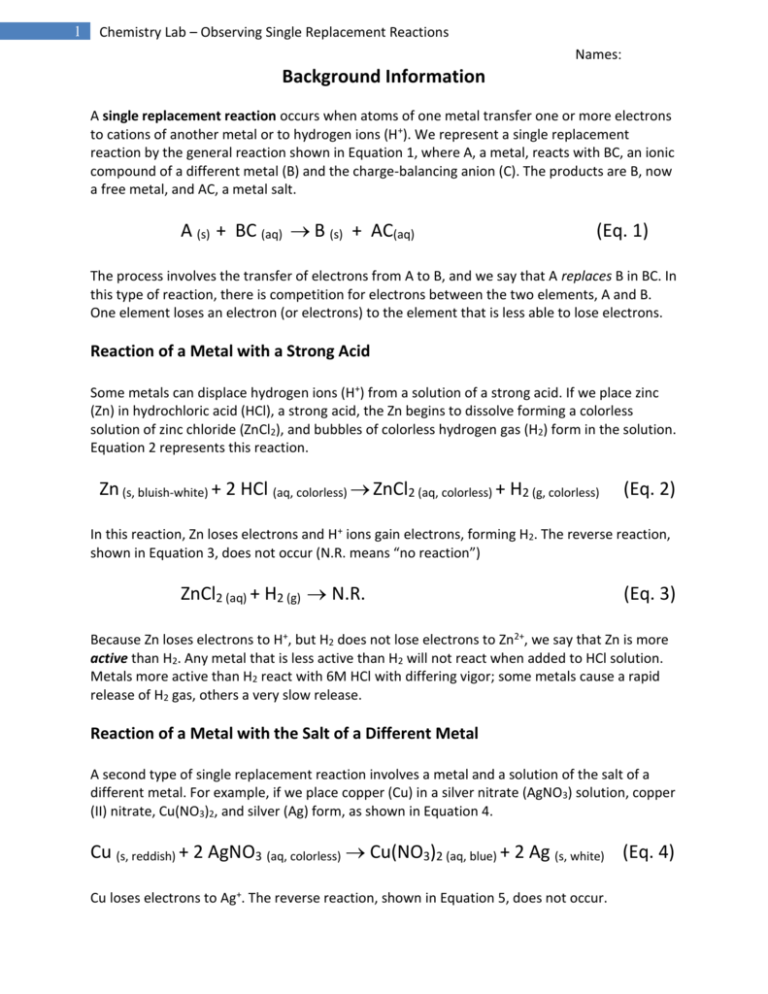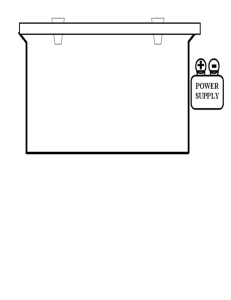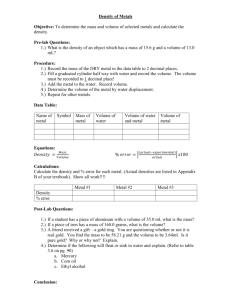Single Replacement Reactions Lab: Chemistry Experiment
advertisement

1 Chemistry Lab – Observing Single Replacement Reactions Names: Background Information A single replacement reaction occurs when atoms of one metal transfer one or more electrons to cations of another metal or to hydrogen ions (H+). We represent a single replacement reaction by the general reaction shown in Equation 1, where A, a metal, reacts with BC, an ionic compound of a different metal (B) and the charge-balancing anion (C). The products are B, now a free metal, and AC, a metal salt. A (s) + BC (aq) B (s) + AC(aq) (Eq. 1) The process involves the transfer of electrons from A to B, and we say that A replaces B in BC. In this type of reaction, there is competition for electrons between the two elements, A and B. One element loses an electron (or electrons) to the element that is less able to lose electrons. Reaction of a Metal with a Strong Acid Some metals can displace hydrogen ions (H+) from a solution of a strong acid. If we place zinc (Zn) in hydrochloric acid (HCl), a strong acid, the Zn begins to dissolve forming a colorless solution of zinc chloride (ZnCl2), and bubbles of colorless hydrogen gas (H2) form in the solution. Equation 2 represents this reaction. Zn (s, bluish-white) + 2 HCl (aq, colorless) ZnCl2 (aq, colorless) + H2 (g, colorless) (Eq. 2) In this reaction, Zn loses electrons and H+ ions gain electrons, forming H2. The reverse reaction, shown in Equation 3, does not occur (N.R. means “no reaction”) ZnCl2 (aq) + H2 (g) N.R. (Eq. 3) Because Zn loses electrons to H+, but H2 does not lose electrons to Zn2+, we say that Zn is more active than H2. Any metal that is less active than H2 will not react when added to HCl solution. Metals more active than H2 react with 6M HCl with differing vigor; some metals cause a rapid release of H2 gas, others a very slow release. Reaction of a Metal with the Salt of a Different Metal A second type of single replacement reaction involves a metal and a solution of the salt of a different metal. For example, if we place copper (Cu) in a silver nitrate (AgNO3) solution, copper (II) nitrate, Cu(NO3)2, and silver (Ag) form, as shown in Equation 4. Cu (s, reddish) + 2 AgNO3 (aq, colorless) Cu(NO3)2 (aq, blue) + 2 Ag (s, white) (Eq. 4) Cu loses electrons to Ag+. The reverse reaction, shown in Equation 5, does not occur. 2 Chemistry Lab – Observing Single Replacement Reactions Names: 2 Ag (s, white) + Cu(NO3)2 (aq, blue) N.R. (Eq. 5) We say that Cu is a more active metal than Ag because Cu loses electrons more easily than Ag does. Solutions of metal salts may be acidic. Therefore, sometimes H2 bubbles are seen when we add a metal to a solution of a different metal salt. H2 production may or may not be accompanied by the reaction of the metal with the other metal salt. In order to conclude whether or not one of the metals is more active than the other, we must look for other evidence of a reaction having taken place. Example Problem Solution You are asked to determine whether Zn is more active than Cu, and to write equations for the reactions you observe. When you place Cu in a colorless zinc sulfate (ZnSO4) solution, there is no apparent change in the solution. When you place in a blue copper (II) sulfate (CuSO4) solution, a reddish solid forms in solution, and the intensity of blue in the solution markedly decreases. (1) Write the equation for the reaction of Cu with ZnSO4 Cu(s, reddish) + ZnSO4 (aq, colorless) N.R. (2) Write the equation for the reaction of Zn with CuSO4 Zn(s, bluish-white) + CuSO4 (aq, blue) ZnSO4 (aq, colorless) + Cu (s, reddish) (3) Draw conclusions from your observations regarding the relative reactivity of Cu and Zn. Zn is more active than Cu, because Zn can transfer electrons to Cu 2+, but Cu cannot transfer electrons to Zn2+ In This Experiment You will establish the relative activities of aluminum (Al), iron (Fe), copper (Cu), and hydrogen (H2). You will determine the order from observations of chemical changes that occur when you combine various pairs of these elements and solutions of their salts and of the metals with 6M HCl Procedure I. Part A: Activity of Metals 1. Obtain three 4-cm pieces each of Al wire, Cu wire, and Fe wire. Clean each piece of metal with sandpaper to remove any metallic oxide and expose the metal surface. Record the physical characteristics of the metals such as their color, texture, and luster on your Data Sheet. 2. Use a Pasteur or Beral pipet to transfer 3 mL of 6M HCl into each of three test tubes. Record your description of 6M HCl, including its color. 3 Chemistry Lab – Observing Single Replacement Reactions Names: Caution: 6M HCl is corrosive, toxic substance that can cause burns Note: For each of the following steps, observe the reaction mixture for 5 min before recording any observations. In some parts of this experiment, a reaction will not occur. When such is the case, write N.R. in the appropriate space on your Data and Observations sheet. 3. Place a 4-cm piece of Al wire in one test tube containing 6 M HCl. Place a 4-cm piece of Cu wire in the second test tube. Place a 4-cm piece of Fe wire in the third test tube. After 5 min, record your observations of each reaction mixture 4. Discard the acid solutions and any unreacted metal in the containers specified by your laboratory instructor. Wash the test tubes. Rinse them with tap water and then with distilled or deionized water. II. Reacting Metals with Solutions of Metallic Salts 5. Use a Pasteur or Beral pipet to transfer 3 mL of 0.5 M aluminum sulfate, Al2(SO4)3, into each of two test tubes. Record your observations of 0.5 M Al2(SO4)3, including its color. 6. Place a 4-cm piece of Fe wire in one of the test tubes containing 0.5 M Al2(SO4)3. Place a 4-cm piece of Cu wire in the second test tube. After 5 min, record your observations of each reaction mixture. 7. Discard the solutions and any unreacted metal into containers specified by your laboratory instructor. Wash the test tubes. Rinse them with tap water and then with distilled water. Caution: Iron (II) sulfate solution is irritating. 8. Use a Pasteur or Beral pipet to transfer 3 mL of 0.5 M iron (II) sulfate (FeSO4) into each of two test tubes. Record your description of 0.5 M FeSO4, including its color. 9. Place a 4-cm piece of Al wire in one of the test tubes containing 0.5 M FeSO4. Place a 4-cm piece of Cu wire in the second test tube. After 5 min, record your observations of each reaction mixture 10. Discard the solutions and any unreacted metal into containers specified by your laboratory instructor. Wash the test tubes. Rinse them with tap water and then with distilled water. Caution: Copper (II) sulfate solution is toxic and irritating 11. Use a Pasteur or Beral pipet to transfer 3 mL of 0.5 M CuSO4 into each of two test tubes. Record your observation of 0.5 M CuSO4, including its color. 12. Place a 4-cm piece of Al wire in one of the test tubes containing 0.5 M CuSO4. Place a 4-cm piece of Fe wire in the second test tube. After 5 min, record your observations of each reaction mixture. 13. Discard the solutions and any unreacted metal into containers specified by your laboratory instructor. Wash the test tubes. Rinse them with tap water and then with distilled water. 4 Chemistry Lab – Observing Single Replacement Reactions Names: Post-Laboratory Questions 1. Assume that you mixed HCl and CuSO4 solutions. If a reaction would have occurred, write an equation for the reaction. If no reaction occurs, explain why (Hint: Use the example given in the Background section for help) 2. Zn is less active than Mg. Write the equations describing what occurs when you mix: a. Zn with 0.5 M magnesium chloride, MgCl2. (If no reaction occurs, write N.R.) b. Mg with 0.5 M ZnCl2. (If no reaction occurs, write N.R.) 3. Based upon your laboratory results, which metal, Cu, Fe, or Al, would be most affected by acid rain? Briefly explain. 4. Based on your laboratory results, will acidic foods cooked in a cast iron skillet become Fe2+-enriched because of a reaction between the acidic food and the skillet? Briefly explain. 5 Chemistry Lab – Observing Single Replacement Reactions Names: Data Sheet I. Reacting Metals with 6 M HCl Metal/ reactant Appearance Al Fe Cu 6M HCl Metal Description of reaction mixture 5 min after mixing with 6 M HCl Did reaction occur? (Y or N.R.) Al Fe Cu II. Reacting Metals with Solutions of Metallic Salts Appearance of 0.5 M Al2(SO4)3: Metal Fe Cu Description of reaction mixture 5 min after mixing with 0.5 M Al2(SO4)3 Did reaction occur? (Y or N.R.) 6 Chemistry Lab – Observing Single Replacement Reactions Names: Appearance of 0.5 M FeSO4: Metal Description of reaction mixture 5 min after mixing with 0.5 M FeSO4 Did reaction occur? (Y or N.R.) Description of reaction mixture 5 min after mixing with 0.5 M CuSO4 Did reaction occur? (Y or N.R.) Al Cu Appearance of 0.5 M CuSO4: Metal Al Fe 7 Chemistry Lab – Observing Single Replacement Reactions Names: Calculations and Conclusions I. Reacting Metals with 6 M HCl 1. Write the equation for each reaction you observed when you placed the metal wires in 6 M HCl. 2. On the basis of your results in Part I, arrange the three metals and H2 in order of their decreasing relative activity. Use the symbols “>”, and “=” when appropriate. Briefly explain the basis of the order you selected. _____________ _____________ _____________ _____________ II. Reacting Metals with Solutions of Metallic Salts 3. Write chemical equations for the reactions you observed when you put each metal wire in 0.5 M Al2(SO4)3. 4. Write chemical equations for the reactions you observed when you put each metal wire in 0.5 M FeSO4 8 Chemistry Lab – Observing Single Replacement Reactions Names: 5. Write chemical equations for the reactions you observed when you put each metal wire 0.5 M CuSO4 6. Based on your results in Parts I and II, arrange the three metals and H2 in order of decreasing relative activity. _____________ > _____________ > _____________ > _____________ 7. Summarize the chemical evidence you obtained to justify your activity series in question 6 9 Chemistry Lab – Observing Single Replacement Reactions Names: Pre-Lab Questions 1. What are the chemical hazards associated with this lab? 2. What protective equipment should be worn in this lab? 3. What is the proper attire / dress for this lab? 4. Explain why the reaction shown below is a single replacement reaction. Zn(s, bluish-white) + CuSO4 (aq, blue) ZnSO4 (aq, colorless) + Cu (s, reddish) 5. How will you recognize that a single replacement reaction has occurred when you combine: a. An active metal with 6 M HCl? b. An active metal with CuSO4 solution? 6. You are given pieces of Zn and Al, and amounts of ZnSO4 and Al2(SO4)3 solutions. 10 Chemistry Lab – Observing Single Replacement Reactions Names: a. What combinations of these four substances would you mix to illustrate that Zn is less active than Al? b. What specific observations would you make after you’ve prepared each combination? c. Write equations describing your observations.






